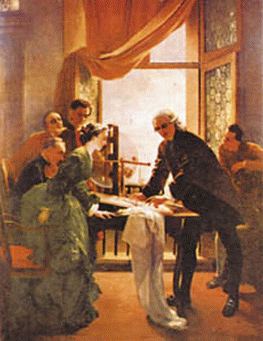Luigi Galvani
(Silvio Bergia)
Luigi Galvani (Bologna, 9 Sept. 1737 – Bologna 4 Dec. 1798) received his degree in medicine and philosophy on 15 July 1759. On 26 February 1782 he was appointed professor of obstetric arts at the Istituto delle Scienze.
 |
Fig. 1: The anatomical theatre of the Archiginnasio where Galvani operated. |
The studies for which Galvani is best known concern so-called animal electricity.
The Swiss physiologist Albrecht von Haller (1708-1777) had shown that a stimulus directly applied to a nerve caused a sharp contraction of the muscle to which it was connected. In Italy, especially in Bologna, due to the influence of authors such as Giovanni Battista Beccaria (Mondový, 1716 – Turin 1781), scientists particularly pursued investigations into the effects of electricity on animate beings. Galvani was also influenced by the studies carried out by Marcello Malpighi.
 Fig. 2: Galvani carries out one of his experiments in the presence of his wife and of some assistants. The painting is preserved in the premises of the University of Bologna. (Credit: Quadreria dell'UniversitÓ degli Studi di Bologna) |
From 1790 onwards, Galvani performed a series of experiments to investigate the reactions to electric stimulations of duly prepared frogs. As a first stage, the aim was to observe the contractions to which the frog's muscles were subjected when directly touched by the conductor of an electrostatic generator. An important turning point took place when he had the impression that similar contractions occurred in a muscle of a frog that an assistant was touching with an uncharged conductor while, by mere chance, another assistant had extracted a spark from the conductor of an electrostatic generator by drawing a conductor close to it. Puzzled by the phenomenon, Galvani carried out a series of experiments that confirmed the effect. |
|
|
(Luigi Galvani - page 1 of 4)
| Forward > |